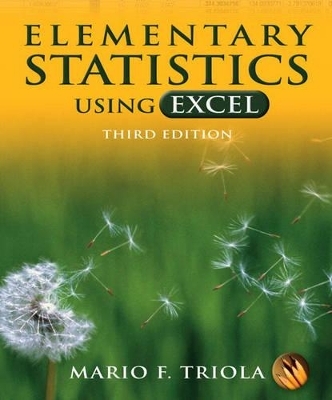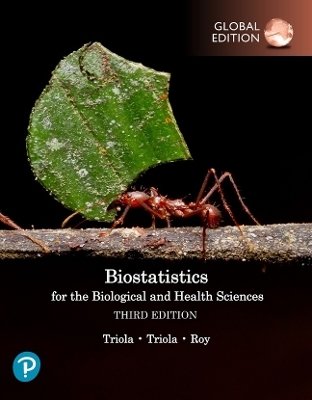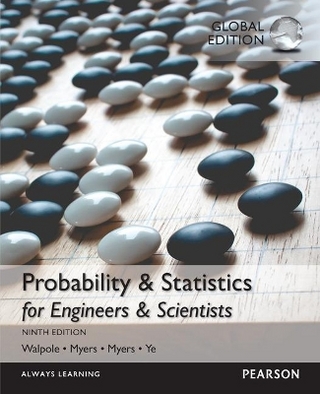
Elementary Statistics Using Excel
Pearson
978-0-321-36513-2 (ISBN)
- Titel erscheint in neuer Auflage
- Artikel merken
Elementary Statistics Using Excel, Third Edition, is a complete introduction to basic statistics, featuring extensive instruction on the use of Excel spreadsheet technology for the analysis of data. Topics are presented with illustrative examples, many of which use real data. The text also identifies required assumptions. Extensive Excel instructions are provided along with typical displays of results, as well as information about Excel's limitations and alternative approaches to problem-solving. The CD-ROM included with each copy of the book contains: DDXL (Version 2.0), a software add-in that enhances and expands the capability of Excel, and Appendix B data sets in the form of Excel workbooks.
Datasets and other resources (where applicable) for this book are available here.
Mario F. Triola is a Professor Emeritus of Mathematics at Dutchess Community College, where he has taught statistics for over 30 years. Marty is the author of Essentials of Statistics, Elementary Statistics Using Excel, Elementary Statistics Using the Graphing Calculator, and he is a co-author of Biostatistics for the Biological and Health Sciences, Statistical Reasoning for Everyday Life and Business Statistics. He has written several manuals and workbooks for technology supporting statistics education. Outside of the classroom, Marty has been a speaker at many conferences and colleges. His consulting work includes the design of casino slot machines and fishing rods, and he has worked with attorneys in determining probabilities in paternity lawsuits, identifying salary inequities based on gender, analyzing disputed election results, analyzing medical data, and analyzing medical school surveys. Marty has testified as an expert witness in New York State Supreme Court. The Text and Academic Authors Association has awarded Mario F. Triola a "Texty" for Excellence for his work on Elementary Statistics.
Chapter 1 Introduction to Statistics
1-1 Overview
1-2 Types of Data
1-3 Critical Thinking
1-4 Design of Experiments
1-5 Introduction to Excel
Chapter 2 Summarizing and Graphing Data
2-1 Overview
2-2 Frequency Distributions
2-3 Histograms
2-4 Statistical Graphics
Chapter 3 Statistics for Describing, Exploring, and Comparing Data
3-1 Overview
3-2 Measures of Center
3-3 Measures of Variation
3-4 Measures of Relative Standing
3-5 Exploratory Data Analysis (EDA)
Chapter 4 Probability
4-1 Overview
4-2 Fundamentals
4-3 Addition Rule
4-4 Multiplication Rule: Basics
4-5 Multiplication Rule: Complements and Conditional Probability
4-6 Probabilities Through Simulations
4-7 Counting
4-8 Bayes’ Theorem (on CD-ROM)
Chapter 5 Probability Distributions
5-1 Overview
5-2 Random Variables
5-3 Binomial Probability Distributions
5-4 Mean, Variance, and Standard Deviation for the Binomial
Distribution
5-5 The Poisson Distribution
Chapter 6 Normal Probability Distributions
6-1 Overview
6-2 The Standard Normal Distribution
6-3 Applications of Normal Distributions
6-4 Sampling Distributions and Estimators
6-5 The Central Limit Theorem
6-6 Normal as Approximation to Binomial
6-7 Assessing Normality
Chapter 7 Estimates and Sample Sizes
7-1 Overview
7-2 Estimating a Population Proportion
7-3 Estimating a Population Mean: d Known
7-4 Estimating a Population Mean: d Not Known
7-5 Estimating a Population Variance
Chapter 8 Hypothesis Testing
8-1 Overview
8-2 Basics of Hypothesis Testing
8-3 Testing a Claim about a Proportion
8-4 Testing a Claim about a Mean: d Known
8-5 Testing a Claim about a Mean: d Not Known
8-6 Testing a Claim about Variation
Chapter 9 Inferences from Two Samples
9-1 Overview
9-2 Inferences about Two Proportions
9-3 Inferences about Two Means: Independent Samples
9-4 Inferences from Matched Pairs
9-5 Comparing Variation in Two Samples
Chapter 10 Correlation and Regression
10-1 Overview
10-2 Correlation
10-3 Regression
10-4 Variation and Prediction Intervals
10-5 Multiple Regression
10-6 Modeling
Chapter 11 Multinomial Experiments and Contingency Tables
11-1 Overview
11-2 Multinomial Experiments: Goodness- f-Fit
11-3 Contingency Tables: Independence and Homogeneity
11-4 McNemar’s Test for Matched Pairs
Chapter 12 Analysis of Variance
12-1 Overview
12-2 One-Way ANOVA
12-3 Two-Way ANOVA
Chapter 13 Nonparametric Statistics
13-1 Overview
13-2 Sign Test
13-3 Wilcoxon Signed-Ranks Test for Matched Pairs
13-4 Wilcoxon Rank-Sum Test for Two Independent Samples
13-5 Kruskal-Wallis Test
13-6 Rank Correlation
13-7 Runs Test for Randomness
Chapter 14 Statistical Process Control
14-1 Overview
14-2 Control Charts for Variation and Mean
14-3 Control Charts for Attributes
Chapter 15 Projects, Procedures, Perspectives
15-1 Projects
15-2 Procedures
15-3 Perspectives
Appendices
Appendix A: Tables
Appendix B: Data Sets
Appendix C: Excel References
Appendix D: Glossary
Appendix E: Bibliography
Appendix F: Answers to Odd-Numbered Exercises (and All Review
Exercises and All Cumulative Review Exercises)
Credits
| Erscheint lt. Verlag | 20.7.2006 |
|---|---|
| Sprache | englisch |
| Maße | 223 x 264 mm |
| Gewicht | 2032 g |
| Themenwelt | Mathematik / Informatik ► Mathematik ► Statistik |
| ISBN-10 | 0-321-36513-5 / 0321365135 |
| ISBN-13 | 978-0-321-36513-2 / 9780321365132 |
| Zustand | Neuware |
| Haben Sie eine Frage zum Produkt? |
aus dem Bereich

